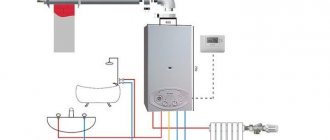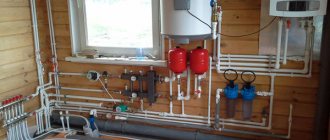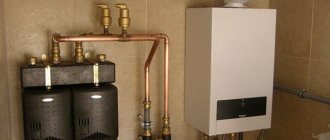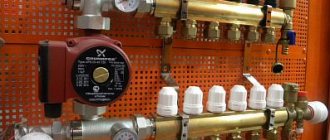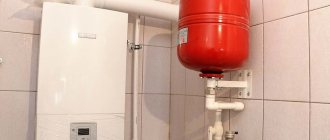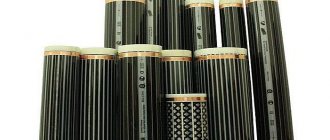Home / Gas boilers
Back
Published: 03/16/2020
Reading time: 6 min
0
10679
The Italian brand Baxi is very popular on the Russian air conditioning equipment market. Gas boilers of this brand are available in several installation options: wall-mounted and floor-mounted, as well as single-circuit for heating and double-circuit for hot water supply.
The manufacturer’s specialists made sure that the installation and operation processes were as simple as possible and accessible to any user. Therefore, to connect the Baxi boiler to operation, the owner does not need to make significant efforts.
- 1 Advantages of Baxi boilers and equipment
- 2 Piping diagrams for Baxi heating systems 2.1 Two-pipe scheme
- 2.2 Single-pipe scheme
- 2.3 Combined diagram of the Baxi gas heating system
- 5.1 System clogging and cleaning
Device and main elements
In terms of their design, TM Baksi units are not much different from other gas boilers. They consist of several components.
Gas burner device
This node includes several elements:
- Gas burner: in the most affordable models, a burner with constant power is installed, in more expensive ones - with step control. To maintain a constant temperature in the room, the automation system has to periodically extinguish such burners and then re-ignite them. The most expensive Baksi boilers are equipped with modulating burners, the power of which is smoothly regulated. Such burners operate constantly and in the most optimal mode, so the set temperature is maintained with high accuracy.
- Combined gas valve: allows or blocks the gas supply to the burner depending on the signals from the automation devices.
- Ignition unit: consists of an electronic circuit and an electrode. This unit converts the mains voltage supplied to it into high-voltage high-frequency pulses, which are supplied to the electrode. As a result, a spark flashes between the electrode and the burner (in some models, between two electrodes), igniting the gas-air mixture on the burner.
The combustion chamber of TM Baksi boilers is closed, that is, air is taken into it from the street. The only exception is the Luna-3 Comfort 240i model, which has an open camera.
The pipe for connecting the gas supply line is located in the middle between the pipes for connecting the heating system.
Heat exchanger
The latter are more efficient due to their high thermal conductivity.
The successful design of the heat exchanger allows you to absorb 90.8% of the heat generated in the combustion chamber (some models have a slightly lower efficiency - 88.7%).
In addition to the main heat exchanger, the Baksi heater may have another one designed for preparing hot water. Such boilers are called double-circuit boilers. Some models, for example, Baxi Ecofor 24, can heat water in an external boiler.
A mesh filter is installed at the inlet of the heat exchanger.
Automation system
All units of this brand use energy-dependent automation. The total power consumption of the boiler, depending on the model, is 135 or 165 W. For most models, for example, Luna-3, Eco-3, Slim, Nuvola, the automation is weather-sensitive.
This means that in addition to the timer and room thermostat, you can connect an outdoor temperature sensor to it. Taking into account weather conditions allows the system to promptly switch the boiler to the optimal mode, which makes the heating system more economical.
The wall-mounted model Luna-3 Comfort (3rd generation boiler) uses a temperature sensor instead of a room thermostat.
Internals of the Luna boiler
Analyzing the information received from it and from the street temperature sensor, this boiler itself calculates the dependence of the coolant temperature on the air temperature outside. This property is called self-adaptation.
Coolants
Most Baksi boilers can work with antifreeze. An exception is all condensing boilers and units with Main Fore bithermic heat exchangers. But if antifreeze is used incorrectly, problems of the following nature may arise: due to insufficient heat removal (when using overly concentrated antifreeze), constant overheating of the system is observed. As a result of elevated temperatures, the coolant begins to decompose, changes color - it becomes dark brown, and precipitation forms in the system. As a result, heat removal deteriorates, overheating becomes even greater, due to local boiling of the coolant, the coil begins to make noise, tremble and knock, and plaque also forms inside it. It cannot be eliminated, so replacement is required. To prevent a milking situation, only specialized antifreezes developed specifically for heating systems can be poured into the system.
The cast iron heat exchanger is almost completely clogged after six months of using antifreeze and constant overheating
There is one more subtlety when using antifreeze liquids: it is advisable to dilute them only with distilled water (although for the most part they should not be diluted). As a last resort, you can use water with a hardness of no more than 5 mEq/l. The use of harder water often leads to sedimentation, which will affect the efficiency of the system and can lead to overheating and, again, to replacing the heat exchanger.
Similar situations may also arise when mixing antifreeze with different additive chemical bases. In this case, decomposition of the coolant may also begin with precipitation and clogging of the heat exchanger. If you do not know or do not remember what composition is in the system, you need to completely drain it and fill in a new one. Don’t forget about the service life of antifreeze – it is often 2-3 years, after which it needs to be drained. Wash the system and power it again.
You can only mix antifreezes of the same chemical composition. If you don’t remember which one was poured into the system, it is better to completely drain it and fill it with a new one
When using anti-freezing compounds, you must also take into account that their thermal conductivity is 15-20% lower than that of water. Therefore, when designing a system, it is worth using either larger radiators or installing more of them. Due to lower thermal conductivity, heat is also removed from the heat exchanger worse; in order to avoid overheating and all the problems that follow, it is worth installing a more powerful circulation pump. So, when using “antifreeze” at -25oC, the pump should be more powerful in pressure by 50-60%, and in flow – 10-15%.
The thermal conductivity of antifreeze is less than that of water, which is why larger radiators are required to maintain normal room temperatures
When using boilers with a built-in circulation pump, the problem can be solved in two ways: by replacing the standard one with a more powerful one, or by using larger cross-section pipes and radiators with lower resistance when building the system. If the system is already ready and it is not possible to replace anything, you can reduce the boiler power (built-in function).
When using antifreeze, you need to choose larger expansion tanks, since they have a greater expansion coefficient than water. Using an insufficient expansion tank can lead to its failure. When designing a system with an “anti-freeze”, the volume of the expansion barrel is taken to be 15% of the total displacement of the system.
Increased demands when using antifreeze and on the quality of connections: these liquids are more fluid, therefore all connections and welds must be airtight.
Operating principle
The operation of the boiler is to heat the coolant entering the primary heat exchanger using a circulation pump. At the outlet, the hot heating agent passes through a three-way valve, where it is mixed in a given proportion with a colder return flow, as a result of which the temperature of the coolant acquires the desired value and is sent to the heating system.
Hot water is heated in a secondary indirect heat exchanger. The heat source for it is the hot heating agent, which has not yet entered the three-way valve.
The operation of all components is constantly monitored by a system of sensors that transmit a signal to the control board.
When changing the nominal mode, the display shows an error code related to a specific unit or part of the boiler.
Clogged systems
Dirt and deposits in the heating system can appear not only from the water supply (you need to install mesh filters there) or from the decomposition of antifreeze. Even when installing new elements and starting the system without flushing, the filters can become clogged: in the production of many elements of the heating system, various technological lubricants, powders, etc. are used. And their number can only increase during installation. Therefore, before powering the system and connecting it to the boiler, you need to flush it.
A similar procedure (flushing) should be carried out periodically - when replacing antifreeze or simply for preventive purposes.
Principle of operation
A control board is installed inside the boiler, which controls all the actions of the unit components. It has special contacts, which by default are connected by a special jumper. They are used to connect the thermostat.
While the jumper is in place, the operation of the system is subject to its own logic - the coolant temperature is set, the boiler heats the heating agent to the specified parameters and turns off when they are reached until the water cools down to the lower limit.
When connecting the thermostat, the jumper is removed. The device turns out to be connected to the gap, so all control of the boiler operation passes to it. The work process becomes smoother, frequent starts and stops of heating stop. The air temperature changes more smoothly.
This method of control gives a more successful effect, allowing you to reduce gas consumption and seriously save on heating.
There are many design options for room thermostats. For Baxi boilers, it is possible to use any of them, which is very convenient for users.
All types of thermostats can be divided according to individual characteristics:
Installation location
According to the installation location, all thermostats can be divided into indoor and outdoor (external). The first ones are mounted indoors, the second ones are placed outside and monitor the state of external weather and temperature conditions.
Most owners prefer to control the internal conditions of the premises, since they have a greater impact on the microclimate of the home. External devices are suitable for residents of southern regions, where the thermal insulation of walls is not so effective.
How to properly install a wall-mounted boiler
Before installation, unpack the heat generator and check the completeness of the device. Make sure the stock fasteners will fit your walls. For example, special fastenings are required for aerated concrete; ordinary dowels are not suitable.
We follow the following order of work:
Important point. When installing a wall-mounted boiler in a wooden house, the wall should be protected from fire, these are the requirements of the standards. Between the rear panel of the unit and the combustible structure, a sheet of roofing steel is attached, protruding 100 mm beyond the body, as shown in the photo.
When marking holes in a wooden log wall, make sure that the fastening is on the crest of the log. Screw the hooks directly into the wood, without plastic plugs.
Malfunctions and error codes of the Baxi gas boiler
The microprocessor control and monitoring system of a modern gas boiler detects a malfunction and displays an error code indicating a particular malfunction in the operation of the boiler components and assemblies.
Error code on the display of the BAXI gas boiler. The display backlight flashes synchronously with the displayed fault code.
The boiler control system reacts differently to the occurrence of a malfunction. Depending on the possible consequences of the malfunction:
- The operation of the boiler is immediately blocked in an emergency. The boiler turns off. Error codes: E01, E02, E04, E07, E25, E27, E40, E41, E42, E43, E50, E62, E65. It is necessary to eliminate the malfunction and restart the boiler using the “R” button (keep pressed for at least 2 seconds).
- The boiler operation stops abnormally, but is not blocked. After the problem is resolved, the boiler will automatically continue to operate with the previous user settings.
- There are errors - warnings that do not require immediate intervention, in which the boiler operation does not stop.
Boilers with an open combustion chamber: chimney and air flow
In order for the equipment to work normally and not shut down due to insufficient draft, a vacuum of at least 3 Pa, or better yet 5 Pa, must be created at the boiler output. Therefore, you cannot use a narrowed chimney: its diameter should be slightly larger than the size of the outlet pipe. When designing a chimney, it is necessary that at the boiler outlet there is a vertical section with a height of at least two of its diameters or at least 0.5 meters.
When the pipe is installed on the roof, it must rise above the ridge by at least 0.5 meters. The chimney itself can have no more than three bends at 90o, and the maximum length of the horizontal section is 3 meters. For better draft, you need to provide a slope towards the vertical section of the chimney - 1 cm for each meter of horizontal section. The total height of the chimney from the burner to its top should be 4-5 meters.
If the house is located next to a taller building, it may not be possible to achieve the necessary draft. The problem is solved by the use of turbocharged boilers with a closed combustion chamber.
For stable operation of the boiler, a properly constructed chimney is required (click on the picture to enlarge the size)
For normal ignition of boilers with an open combustion chamber, a sufficient amount of oxygen is required. To do this, the room where the boiler is installed must have good ventilation and draft. If there is a lack of air when igniting the boiler, a popping sound is heard. What is needed for good draft is described above, and to supply air, you can arrange for it to be taken from the street with grilles vented in the area where the burner is located.
If it is quite difficult to create an air flow at a sufficient level, it is advisable to use equipment with a closed combustion chamber and forced removal of combustion products - turbocharged boilers.
Advantages of Baxi boilers and equipment
The BAXI brand belongs to BDR Thermea, a large European manufacturer of household and industrial heat and power equipment.
The units are equipped with auxiliary devices of the same brand: a circulation pump for modifications with forced movement of the coolant, a blower fan in closed fireboxes and a safety group.
They ensure that the unit reaches factory operating parameters and have advantages in layout compared to devices that are assembled with components from different manufacturers.
The main advantages of BAXI boilers:
- high thermal efficiency, efficiency up to 92%;
- wide power range from 14 to 80 kW;
- environmental Safety;
- refers to energy efficient equipment;
- Wide range of settings for thermal conditions and automatic maintenance of specified operating parameters.
The latest modifications are available with a powerful self-diagnosis system, frost protection and antibacterial protection.
Integrated weather-dependent automation provides sanitary living conditions in the house, while guaranteeing low cost of generated thermal energy for heating and hot water needs.
Baxi device parameters
The power of the Baxi boiler is the most important parameter when choosing a gas device. The power indicator determines how much area the system can heat. Baxi offers a wide selection of models of different power (from a couple of kW to several thousand). This makes it possible to choose a Baksi boiler, both for heating a country house, and several buildings, huge buildings.
But only a technical specialist, having a certain amount of knowledge, will be able to determine the required power of the device.
Main components and principle of operation
The Baxi line of gas boilers includes a number of models that differ in volume, type of installation, and functionality. However, the principle of their operation is generally similar.
The most popular boiler models:
- Baxi Luna (Baxi Luna).
- Baxi Slim (Baxi Slim).
- Baxi Main four (Baxi Main four).
- Baxi Main 24 fi (Baxi Main 24 fi.
- Baxi Nuvola (Baxi Nuvola).
- Baxi EKO four (Baxi Eco for, Baxi Ecofor).
Gas boiler baxi luna-3 1.310 - price and where to buy
Baxi Luna
According to the type of installation, gas boilers are divided into wall-mounted and floor-mounted.
The wall heater is fixed using special brackets in any convenient place, which makes wall-mounted models very popular. Chambers with a closed combustion chamber, for example, Baxi Main 24 fi, have increased efficiency and environmental friendliness in a small size.
The volume of coolant in the heat exchanger depends on the model, in the most powerful it reaches 80 liters. In terms of functionality, models can be single-circuit - for heating, or double-circuit - in addition to the heating system, they also supply the hot water circuit.
They can operate both on natural main gas and on liquefied gas from cylinders, making it possible to install them in non-gasified areas. The boilers are completely volatile and require connection to an alternating voltage network.
Operating principle of gas heating equipment:
- Sensors analyze the temperature in the room, and when the minimum value is reached, they send a signal to turn on the circulation pump.
- The pump turns on, creating a vacuum in the return pipe, and the heated water enters the heating system.
- The microprocessor sends a signal to ignite the burner at low power, it gradually increases, and the coolant is heated to a temperature specified by the user.
- Then the boiler operates in modulation mode - it maintains the temperature within the specified limits, turning on when it drops.
At any of these stages, a malfunction may occur, which the boiler notifies using coded errors.
Possible malfunctions of the Baxi Main for, Baxi Main 24 fi, Baxi Eco for boiler:
- the burner goes out immediately after switching on or during the heating process (error codes e01, e04);
- ignition of the boiler is impossible;
- overheating occurs (error code e02);
- The water pressure in the system drops (error code e10);
- extraneous noise is heard during operation;
- there is popping noise in the combustion chamber;
- the coolant does not heat up to the set temperature;
- One of the sensors fails (different error codes may appear).
The most common causes of certain malfunctions, according to service center specialists, may be:
- improper installation of the heating system;
- errors when connecting the boiler to the electrical network;
- water getting into the circuit board, burner or electrical part of the boiler;
- low quality of network water or other coolant;
- sudden drop in gas pressure;
- The network voltage drops or increases unacceptably.
The resulting malfunctions can be easily eliminated by adjusting the boiler, but sometimes it is necessary to call a specialist to replace boiler parts.
If you are not confident in your skills in setting up gas equipment, it is better to contact a service center. Incorrectly performed repairs can lead to complete failure of the boiler!
Baxi heating system wiring diagrams
Despite the fact that the manufacturer has taken care to provide the user with all the necessary documentation for connecting the boiler to the heating system, in order to maintain warranty obligations, it is not recommended to do this yourself; you need to invite a service department, which will be recommended in the store when purchasing the unit.
This will allow not only to maintain the warranty on the equipment, but also to resolve future issues with the city gas inspection, which will have to give permission to operate gas equipment.
Thus, the user’s task will be to select the desired strapping pattern. It will depend on the installed heating circuit. According to existing heat supply schemes, it can be:
- two-pipe for houses with a large heating area;
- single-pipe with natural circulation for houses with small heated area;
- combined, for multi-circuit heating systems.
Two-pipe scheme
The two-pipe Baksi circuit is made from a heating source, a circulation pump, an expansion tank, a safety group, a mud trap and a coolant purification filter.
The principle of operation of a two-pipe network:
- Cold water enters the heating circuit through the filter to the suction of the network pump.
- Water enters the boiler and is heated to the temperature set by the user on the operating panel.
- The heated coolant is supplied to the heating system.
- From the supply pipeline there are branches to each heating device.
- Cooled water from the radiator flows through the return branch into the common return line and is pumped into the unit for the next heating cycle
Air vents and a heat sensor are installed on the heating device, which regulates the coolant depending on the set temperature.
Thanks to this scheme, the radiators heat up evenly and, if necessary, can be completely individually switched off.
Single-pipe scheme
A single-pipe scheme with natural circulation is an affordable and economical piping scheme designed for small-sized one-story houses.
The scheme is as follows:
- The gas boiler is installed on the wall in the kitchen.
- The supply from the device comes through one pipeline, to which all radiators are connected in series.
- The heated coolant from the device enters the supply line, which has an upper distribution, and then sequentially passes through all the heating radiators.
- From the last radiator it flows into the return line and then into the boiler for a new heating cycle.
- The movement of the medium occurs under the influence of natural circulation that occurs due to the temperature difference in the supply and return. For efficient movement, the supply and return pipelines are installed with a slope. The vent is installed at the highest point, usually in the attic.
- An expansion tank is installed in the system to compensate for the thermal expansion of the coolant.
The disadvantage of this scheme is that the first batteries along the coolant flow are overheated, and the last ones are underheated. The efficiency of the circuit can be increased by integrating a circulation pump into the circuit, which will increase the heating area from 40 m2 to 150 m2.
Combined diagram of the Baxi gas heating system
This is the most progressive boiler piping scheme; it has several independent heating circuits - a radiator and a “warm floor” system.
Typically, radiators are installed in bedrooms and the living room, and in other rooms in the kitchen, bathroom and other utility rooms, “warm floors” are installed, which operate at lower temperature conditions and can work with reverse coolant.
In this option, the system will more fully remove heat from the heating network water. At the same time, the lower the temperature in the return pipeline, the higher the efficiency of the heating network installation is ensured.
The return coolant temperature limitation is set by the manufacturer for a specific unit model in order to counteract the formation of condensation in the flue gases. To distribute the coolant across different circuits, you will need to install a Baxi boiler with a hydraulic manifold and separate circulation pumps for each circuit.
Power Requirements
Installation of a voltage stabilizer is required - automation does not tolerate surges well. In addition, for normal operation of automation, a sinusoid close to ideal is required, which is not always present in our electrical networks. Therefore, instead of a stabilizer (or together with it), it is necessary to install an inverter, the output of which will be a stable frequency of 50 Hz (which our networks also cannot boast of) and a sine wave close to ideal. An on-line power supply can also solve the problem. In this case, you will not only supply the required voltage, but also ensure that the boiler operates for some not very long time during a power outage. Connecting rechargeable batteries to the UPS can make energy dependence even less.
For Baksi boilers, both the shape of the pulses and the stability of the characteristics are important
But that's not all the power requirements. It is also necessary to provide protection against impulse currents - we need SPDs that will protect against sudden changes when turning on powerful equipment in the neighborhood or during a thunderstorm. Although, as experience shows, during a thunderstorm the only thing that can save your boiler is a plug removed from the socket, and even then only with proper grounding - there have been cases when the potential “pierced” the automation through the gas pipe. In order to prevent such a situation, all metal pipelines entering the house must have dielectric inserts.
Network voltage stabilizer
Conclusions and useful video on the topic
The following video will clearly demonstrate the installation, connection and configuration stages of the Baxi boiler:
Information about the installation process of the Baksi wall-mounted boiler and the rules for connecting it is needed to control invited performers. Unfortunately, not all of them please with a conscientious attitude to work and knowledge of all the nuances. If the owner of a gas-using unit cares about his own safety and the normal operation of the device, the information we present will not be superfluous.
Would you like to tell us how you installed and set up a boiler with the Baksi logo in your home or country house? Do you have useful information on the topic that will be useful to future owners of the unit? Please leave comments in the block form below, post photos related to the topic of the article, and ask questions.
Pressure setting
To increase the pressure, a make-up valve is used, and to release the pressure, a drain valve is used.
The optimal value is considered to be 0.7-1 mBar. Usually Baxi boilers independently maintain the desired value, but sometimes failures occur. If there is a constant drop that does not disappear after the system is recharged, then there is an OM leak somewhere.
This could mean either leaking pipes or radiators, underfloor heating systems or other external elements.
Often the problem occurs due to a faulty bleed valve. An abnormal increase in pressure may be due to a malfunction or open make-up valve or damage to the expansion tank membrane.
Grounding
Between grounding and neutral, the potential must be less than 0.5 V. If this requirement is not met, there is a constant potential on the boiler grounding block, which causes a number of malfunctions: malfunctions of the automation, loss of ionization current (burner control), etc. .P. If such a problem exists, it is recommended to install a transformer with galvanic isolation. This allows you to solve problems of insufficiently competent grounding.
If the grounding is incorrect, there is a constant potential on the grounding block, which leads to failures during ignition and frequent shutdowns of the boiler
Recommendations for reducing operating costs
If all operational settings are made in accordance with the tabular data given by the manufacturer, then the equipment will consume energy very economically, generating the necessary heat in the volume required by the owners.
To do this you should:
For systems with radiators or thermosiphons, select the temperature of the coolant at the boiler outlet +60ºС. It is worth increasing it only if, during operation of the unit, comfortable heat in the room was not obtained. Adjust temperature conditions in accordance with the manufacturer’s instructions and the purpose of the room. To heat bedrooms and other rarely visited rooms, the heating temperature can be set below average. Do not exceed the temperature background recommended by the manufacturers of the heating devices included in the circuit. Use indoor and outdoor temperature sensors that record temperature increases/decrease. The thermostat connected to them will independently start/stop the boiler as needed. Adjust the temperature of the coolant by the hour using a timer. At night, for example, it can be lowered by 3-5 ºС.
It should be remembered that by increasing the temperature in the room being treated by just 1º, we immediately increase costs by approximately 6%.
In order not to constantly change the coolant temperature settings during the difficult autumn-spring period, it is better to install an outdoor temperature sensor. If you don’t find a suitable model or don’t have the funds to buy the original, you can build a homemade device like this:
from To build an outdoor sensor that reads the outside temperature, you can buy a regular NTC thermistor. The example uses B57861-S-65-18 at 10 kOhm 103 A40 with an error of 1%. The device is installed in a plastic headphone case to protect it from atmospheric agents and is wrapped in foil to prevent heating from the sun. In order to bring the sensor outside, you need to drill a hole in the wall next to the boiler. The thermistor is connected to the boiler using a twisted pair cable. Using the graph presented by the Baksi Corporation, you need to adjust the temperature of the coolant according to the graph displaying its optimal values for different thermometer readings. The sensor is fixed on the outside of the main wall. It is advisable to find a place for it that is not directly illuminated by the sun. On the room side, the hole drilled for the cable is lightly foamed or covered with a plastic plug. Stage 1: Assembling a homemade outdoor sensor. Stage 2: Drilling the wall for output to the outside. Stage 3: Adjusting the coolant according to the outside temperature. Stage 4: Attaching the outdoor temperature sensor.
In case of prolonged absence, it is better to disconnect the boiler from the power supply, but you should not turn off the frost protection system. It is turned off only for the summer period, during which the heating function is abandoned, completely turning off the single-circuit model and switching to the dual-circuit version for the supply of hot water.
In order to save on heating, you should not cover radiators with screens and heavy curtains. They will disrupt normal air circulation and force the boiler to work at full capacity for no apparent reason.
Also, the equipment manufacturer does not recommend micro-ventilation in rooms, keeping the transoms constantly ajar. It is better to open the window wide and ventilate in one gulp than to artificially lower the readings of the room temperature sensor for a long time. It has been proven in practice that it is more economical.
When using the water preparation function, it is better to initially select a temperature that is comfortable for use, without counting on mixing heated and cold water in the mixer. Believe me, thanks to this solution, the thermal energy generated by the generator will not be wasted. In addition, limescale will not settle on the inner walls.
Installation subtleties and configuration nuances
We have already noted that the installation, connection, first start-up and adjustment of the operating parameters of the Baksi gas boiler should be carried out by a specialist from the organization with which an agreement has been concluded for the supply of blue fuel and for the maintenance of gas processing units. After applying your own efforts to implement the above steps, you will no longer be able to benefit from the warranty.
All steps of the installation cycle of work are documented. Boiler owners are given papers indicating who installed and connected what. If a malfunction is detected, the contractor will deal with it. If a manufacturing defect is detected, which is extremely rare, all replacement and repair problems are resolved by the gas service.
Image gallery
Photo from
Wall-mounted boiler in the hallway
Well-functioning ventilation system
Floor-standing gas equipment in the boiler room
Floor and wall model in the boiler room
Please note that these gas heat generators can be installed in heating circuits with any heating appliances. Heated floors are no exception, but for them to work, the boiler power should be set to 65ºC at the inlet to the supply pipe. They are suitable for both one- and two-pipe heating circuits, for tee and radial options.
Steps to connect the boiler to communications
Let us list step by step what gas workers must do during the installation and connection of a Baksi gas boiler.
Conventionally, the entire cycle of work can be divided into three main parts, these are:
- Preparation of building structures and communications. Strengthening structures as needed. Laying lines for connection, if necessary.
- Hanging the boiler on the wall and connecting to communications. Purely mechanical work that requires strict adherence to the diagram and recommendations of the unit manufacturer.
- Performing the first launch and setting up operating parameters. The first launch is the responsibility of representatives of the gas company. The user can set the settings himself.
All actions are carried out in a thoroughly thought-out and clearly worked out manner by the boiler manufacturer.
The manufacturer of equipment for heating coolant and hot water supplies the installation diagram with the unit. When connecting communications, you must strictly follow the instructions
The preparatory period includes:
- Inspection of the premises to confirm the possibility of installing equipment using gas.
- Drawing up a contract for the work, attaching a connection diagram for a gas boiler with the Baksi logo and an accurately calculated estimate. It should indicate the prices for the work and the cost of materials purchased by the company for the installation of the thermal energy generator.
- Cleaning used heating and hot water systems from mineral deposits and contaminants deposited on the walls of pipelines and devices during operation. Produced by any available chemical.
- Laying communications to the boiler installation site. Only heating and gas supply lines are connected to single-circuit ones, and heating, gas and water supply lines are connected to double-circuit ones.
- Installation of shut-off valves on each communication line. They are needed to shut down the unit in case of repair, accident, or replacement.
- Installation of a dirt filter on the return pipe of the heating system. It is required to collect mineral deposits that may remain after cleaning and will form when the water heats up.
- Connection of a separate power supply line. It is used to ensure that other electrical equipment is not connected in parallel with the device, which creates the risk of a short circuit with fire hazardous consequences.
Connection of communication systems is carried out with the mandatory use of seals. All work must be carried out in accordance with plumbing standards.
The optimal location of the electrical outlet relative to the gas boiler is 30-50 cm from the body. Its installation and laying of the power supply branch is carried out in accordance with the PUE. In addition, the equipment must be grounded using a three-core cable with a grounding wire.
Since the operation of the hot water heater and coolant from Baksi requires power, it is necessary to lay a separate power line to the installation site of the boiler. It should pass at a distance of 30-50 cm from the body
The list of measures for installing the boiler includes:
- Boiler mounting. It is made on a wall with sufficient load-bearing capacity. Fix the unit with anchor bolts; if necessary, cover the wall with non-combustible finishing if it is made of flammable materials.
- Connecting pipelines to the boiler. It is carried out in accordance with the diagram attached to the technical passport by the manufacturer.
- Chimney assembly. The connection of chimneys to Baksi boilers is made only with fasteners supplied by the manufacturer of the unit.
For turbocharged models equipped with a closed combustion chamber, either a coaxial pipe or a regular pipe is connected together with an air supply pipe to the closed burner. The first option is simpler, but more expensive in terms of purchasing a coaxial system. However, it is not a fact that installing two channels for air supply and smoke removal will ultimately cost less.
A conventional chimney is connected to atmospheric models with an open combustion chamber. The products of blue fuel processing are discharged either through a wall into the street space or into the collective chimney of an apartment building.
Chimneys are connected to gas boilers with the Baksi logo using the fasteners included with the device. Turbine models are equipped with coaxial types of chimneys, while atmospheric ones are equipped with conventional ones, which are recommended to be supplemented with condensate collectors
Chimney elbows allow this channel to be brought out in any direction through the wall. Let us note that exits through the walls are mainly in high-rise buildings, the number of storeys of which does not exceed five levels. In private houses, it is preferable to build vertical smoke channels.
Upon completion of the installation work, they proceed to the first launch and configuration.
Launch and commissioning activities
For the first start-up, the gas boiler and the circuits it processes are filled with the medium transported through them. Unlike most wall-mounted models, which can only heat water as a coolant, Baksi units can be filled with antifreeze - an aqueous solution of propylene glycol with antifreeze additives.
The process of filling the boiler and heating circuit with coolant is carried out through a pipe located in the lower part of the unit. After filling, bleed off the air, then, if necessary, replenish the coolant volume in the same way.
After connecting the boiler to the communication lines, it and the associated systems are filled with water. Then they connect to the electrical network and open access to gas. Now you can configure
The commissioning activities are preceded by the following actions:
- Checking the pressure in the system. It should correspond to the recommended values of 1-1.5 bar.
- Connecting the boiler to the power supply.
- Supplying gas to the combustion chamber, for which you need to open the yellow tap at the inlet of the gas pipe in front of the boiler.
It happens that when you turn it on for the first time, the unit is blocked due to the presence of air pockets in the pipes. In the case of Baksi boilers, there is no need to manually bleed the plugs; the system will remove them itself. You just need to press the start button again and hold it for 2 seconds until the burner is activated.
Operating parameters are set using an electronic panel located on the front side of the boiler. To select the heating operating mode there is a button with a stylized battery, for hot water there is a button with a tap.
The operation of the Baxi gas boiler is configured in accordance with a single algorithm:
- Select the button responsible for heating or preparing sanitary water.
- Use the +/- buttons to select the appropriate mode.
- Press the Power button so that the electronic control remembers the set parameter.
If the performance task procedure is completed successfully, the display shows “MEM”. This means that the boiler will operate according to these exact settings until the user decides to make changes.
The basics of setting up a boiler will be mastered by a performer who is completely ignorant of the intricacies. You just need to select a function and then a value, increasing or decreasing the original value
The reluctance to remember the newly selected parameter must be confirmed by pressing the “i” button. The system that has perceived a refusal to change will report this with the message “ESC” on the display.
In order to select and set the boiler operating characteristics, the buttons are held for 6 seconds. To display current information about the operation of the unit, you need to press the “i” button for 5 seconds. If the “INFO” function is activated, the display displays “A00”, instead of which the temperature at the outlet of the heated coolant from the boiler appears.
Then you need to check the dynamic value of the gas pressure at the inlet to the gas burner. When consuming main fuel, it should be 20 mbar. When using a cylinder mixture with a predominance of propane, the dynamic pressure value should be 37 mbar. Measurements are carried out by connecting a pressure gauge to the gas valve fitting.
Next, adjust the maximum and minimum pressure values using the regulator. In this case, again, a gas valve is used, to the fitting of which a sensitive pressure gauge is connected, recording changes in mbar. The values are selected according to the data given in the table by the manufacturer. They depend on the model and the type of gas that the boiler will process.
The operating characteristics of the gas pressure are adjusted in the simplest way - by turning the adjusting screws. The pressure depends on the gas mixture used
The gas coolant and hot water heaters offered to consumers from Baksi are initially configured to process main gas. If the boiler is to “work” in an autonomous system with a group of cylinders or a gas holder, then before performing all the listed settings, the nozzles are replaced. And then they change the voltage on the modulator by selecting parameter F02.
Image gallery
Photo from
Step 1: Removing the combustion chamber faceplate
Step 2: Removing the gas burner
Step 3: Unscrewing the main gas injectors
Step 4: Screwing in the nozzles for the liquefied gas mixture
Do-it-yourself boiler cleaning
You need to drain the water and turn off the tap on the right. If the situation allows, it is better to get rid of water in the heating system. The Zhel device will help: it cleans the system. We connect the device to the Baxi pipes. Remove the cover of the device and fill in the cleaning liquid. Turn on the Zhel device. We work for several hours: we change the direction of the washing liquid. After two hours of cleaning, turn off the device and turn off the tap. When the liquid goes into the device, remove the hoses. We carry out connecting operations of the boiler and heating system. The described procedure will prolong the operation of the boiler, remove scale, and prevent blockages.
Cleaning the secondary heat exchanger
Again he resorts to the washing device. We perform connection operations, turn on Zhel. Close the gas tap and open the hot water tap. Turn off the cleaning device. The liquid will travel along a short circuit of the system.
Before choosing a model and installing a boiler, it is better to listen to a specialist. Baksi boilers have many advantages, but, like all equipment, they do not last forever, and the durability of the devices is not ideal. We assessed the extent of the breakdowns and described the basic steps required for DIY repairs. We hope that you will not regret your purchase and that your boiler will create a warm atmosphere for a long time. And if breakdowns occur, let them be minor and quickly fixable. It’s good when, with a minimum set of tools and in a short period of time, the trouble is eliminated and a warm atmosphere reigns in the house again.
If you think that you can install and connect a gas boiler yourself, you are mistaken. Even if you carefully study the instructions for the Baxi double-circuit wall-mounted gas boiler and acquire the necessary tools, no one will give you permission to carry out such work
It is important to know that the installation, and especially the connection of gas equipment, should be carried out only by experienced craftsmen who are able to complete everything in compliance with the requirements and rules
Upon completion of all work, the technician will certainly perform the first startup of the Baxi gas boiler, which will allow him to check the quality of the work performed. If everything is in order, the equipment is put into operation. Despite the fact that the installation and connection of gas boilers is carried out by a specialist, you should know how to properly install wall-mounted and floor-standing heating boilers, and also carefully study the structure of the Baxi gas boiler - this will allow you to properly operate the equipment in the future.
Automatic boiler functions
Each buyer, purchasing a heating system, places great hopes and demands on it. Therefore, the configuration of gas boilers also includes the structure of microprocessors for regulators of the appropriate types. The boilers are endowed with functional purposes, and also guarantee convenience and comfort in the use of all heating systems and circuits.
Characteristic features of regulators:
- Adjustment based on the readings of the outside temperature sensor. This helps save energy resources and guarantee comfort.
- An optimal schedule is established and adjusted based on utilization rates. This avoids overheating of oxygen into the building, which often occurs in spring or autumn.
- It is possible to program heating by clock for a specific day of the week, as well as lowering the temperature at night. This is all done very simply and profitably, and is also useful, because night sleep is favorable at low temperatures.
Before choosing a model, it is worth finding out what hardness the water entering the system is. Only then, having studied the instructions of the models, choose the one that is ideal for this water. The uninterrupted and efficient operation of the heating system will depend on this.
Kinds
The company produces equipment with various capabilities.
The assortment includes:
- Floor and wall types.
- Single and double circuit.
- Turbocharged and atmospheric (with closed or open burner).
- Cast iron, copper and stainless steel heat exchangers with different capabilities and efficiency.
This abundance of options allows users to choose the optimal installation to suit the needs of a given room.
IMPORTANT!
Baxi boilers are initially manufactured to operate on natural gas, but at any time they can be converted to liquefied gas, for which you need to change the gas burner nozzles.
Selecting boiler power
If it is necessary to select equipment for both heating and hot water supply, more attention should be paid to the preparation of hot water. In this case, if the heated area does not exceed 200 m2, the power of the equipment is selected according to the hot water output. At the same time, the selected power is excessive for the area; it will not interfere with the operation of the equipment: all burners are modulating and with a rated power of 24 kW can operate at 9 kW without compromising performance. Damage to the equipment is caused by prolonged operation at the limit of capacity. That's when problems can start.
When choosing power for an area less than 250 m2, pay more attention to the boiler’s DHW performance (click on the picture to enlarge the size)
If it will be necessary to provide more than one bath at the same time, then in this case additional specialized equipment is required - boilers, since the main purpose of this is heating, and not providing hot water.
In general, to correctly select the power of a heating boiler, it is necessary to carry out thermal calculations that take into account the area of your house, the material from which it is made, and the degree of its insulation. And based on the calculated heat losses, it will be possible to unambiguously select equipment.
Menu for displaying information about the operation of the Baxi boiler
On the display of the Baxi boiler, in the information menu, the designation of the first line A00 alternates with the value of the parameter of this line - 35 ºС.
To display a menu of information about the operation of the boiler on the display located on the front panel of the boiler, press the “i” button for at least 6 seconds.
The “INFO” function is activated and the designation of the first line of the information menu “A00” appears on the display, which is replaced by the display of the temperature parameter.
To move through the lines of the information menu, press the buttons (tap +/-).
BAXI Main Four |Baxi Eco Four | BAXI Four Tech:
Line A00: effective value (ºС) of the domestic hot water temperature (DHW system);
Line A01: value (ºС) of the outside temperature (with an outside temperature sensor connected);
Line A02: Instantaneous value (%) of the gas valve control signal;
Line A03: value (%) of power (MAX R);
Line A04: set value (ºС) of the supply temperature to the heating system;
Line A05: effective value (ºС) of the water supply temperature to the heating system;
Line A06: set value (ºС) of domestic hot water temperature;
Line A07: % flame level value (0 – 100%);
Line A08: current value (l/min x 10) of domestic hot water consumption;
Line A09: the last error detected in the boiler operation.
Connecting the boiler to communications
The Baksi boiler unit is placed in a non-residential area, for example, in the kitchen, subject to reliable supply ventilation providing 3-hour air exchange.
The heating circuit is connected to the supply/return pipes located on the rear panel of the device according to the accepted wiring diagram.
Next, the boiler chimney system is connected:
- Install the chimney pipe through the adapter to the boiler smoke pipe.
- The chimney and the smoke pipe of the unit must have the same dimensions; it is indicated by the manufacturer in the technical documentation.
- The smoke channel is selected in such a way that the chimney section is as short as possible.
- The vertical section of the pipe from the connection point to the tip must be at least 6 m and provide draft in the combustion chamber in the range of 0.8 mm - 3.0 mm water column.
- The thrust is measured while the device is operating.
- The chimney must be firmly attached and must not rest on the boiler unit.
- The places where the pipe passes through the structural elements of the wall, ceiling and roof must be well insulated.
Next, connect the internal elements to the Baxi boiler control module:
- connect a transformer for piezo ignition and a gas pressure switch to the 6-terminal connector;
- connect the main 2-stage valve to the 9-terminal connector;
- connect an additional 2-stage valve to the 3-terminal connector;
- connect the left electrode of the ignition cable and the right electrode of the ionization cable to the piezo igniter;
- install primary temperature and pressure sensors in the technical holes indicated on the piping diagram provided by the manufacturer.
